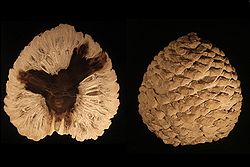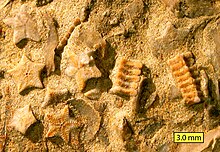Biological explanations
Early naturalists well understood the similarities and differences of living species leading Linnaeus to develop a hierarchical classification system still in use today. It was Darwin and his contemporaries who first linked the hierarchical structure of the great tree of life in living organisms with the then very sparse fossil record. Darwin eloquently described a process of descent with modification, or evolution, whereby organisms either adapt to natural and changing environmental pressures, or they perish.
When Charles Darwin wrote On the Origin of Species by Means of Natural Selection, or the Preservation of Favoured Races in the Struggle for Life, the oldest animal fossils were those from the Cambrian Period, now known to be about 540 million years old. The absence of older fossils worried Darwin about the implications for the validity of his theories, but he expressed hope that such fossils would be found, noting that: "only a small portion of the world is known with accuracy." Darwin also pondered the sudden appearance of many groups (i.e. phyla) in the oldest known Cambrian fossiliferous strata.
Further discoveries
Since Darwin's time, the fossil record has been pushed back to between 2.3 and 3.5 billion years before the present.Most of these Precambrianfossils are microscopic bacteria or microfossils. However, macroscopic fossils are now known from the late Proterozoic. The Ediacara biota (also calledVendian biota) dating from 575 million years ago collectively constitutes a richly diverse assembly of early multicellular eukaryotes.
The fossil record and faunal succession form the basis of the science of biostratigraphy or determining the age of rocks based on the fossils they contain. For the first 150 years of geology, biostratigraphy and superposition were the only means for determining the relative age of rocks. The geologic time scale was developed based on the relative ages of rock strata as determined by the early paleontologists and stratigraphers.
Since the early years of the twentieth century, absolute dating methods, such as radiometric dating (including potassium/argon, argon/argon, uranium series, and, for very recent fossils, radiocarbon dating) have been used to verify the relative ages obtained by fossils and to provide absolute ages for many fossils. Radiometric dating has shown that the earliest known stromatolites are over 3.4 billion years old. Various dating methods have been used and are used today depending on local geology and context, and while there is some variance in the results from these dating methods, nearly all of them provide evidence for a very old Earth, approximately 4.6 billion years.
Modern view
"The fossil record is life’s evolutionary epic that unfolded over four billion years as environmental conditions and genetic potential interacted in accordance with natural selection.The earth’s climate, tectonics, atmosphere, oceans, and periodic disasters invoked the primary selective pressures on all organisms, which they either adapted to, or they perished with or without leaving descendants. Modern paleontology has joined with evolutionary biology to share the interdisciplinary task of unfolding the tree of life, which inevitably leads backwards in time to the microscopic life of thePrecambrian when cell structure and functions evolved. Earth’s deep time in the Proterozoic and deeper still in the Archean is only "recounted by microscopic fossils and subtle chemical signals]Molecular biologists, using phylogenetics, can compare protein amino acid or nucleotide sequence homology (i.e., similarity) to infer taxonomy and evolutionary distances among organisms, but with limited statistical confidence. The study of fossils, on the other hand, can more specifically pinpoint when and in what organism branching occurred in the tree of life. Modern phylogenetics andpaleontology work together in the clarification of science’s still dim view of the appearance of life and its evolution during deep time on earth.
Niles Eldredge’s study of the Phacops trilobite genus supported the hypothesis that modifications to the arrangement of the trilobite’s eye lenses proceeded by fits and starts over millions of years during theDevonian.Eldredge's interpretation of the Phacops fossil record was that the aftermaths of the lens changes, but not the rapidly occurring evolutionary process, were fossilized. This and other data led Stephen Jay Gould and Niles Eldredge to publish the seminal paper on punctuated equilibrium in 1971.
Example of modern development
An example of modern paleontological progress is the application of synchrotron X-ray tomographictechniques to early Cambrian bilaterian embryonic microfossils that has recently yielded new insights ofmetazoan evolution at its earliest stages. The tomography technique provides previously unattainable three-dimensional resolution at the limits of fossilization. Fossils of two enigmatic bilaterians, the worm-likeMarkuelia and a putative, primitive protostome, Pseudooides, provide a peek at germ layer embryonic development. These 543-million-year-old embryos support the emergence of some aspects of arthropoddevelopment earlier than previously thought in the late Proterozoic. The preserved embryos from China andSiberia underwent rapid diagenetic phosphatization resulting in exquisite preservation, including cell structures. This research is a notable example of how knowledge encoded by the fossil record continues to contribute otherwise unattainable information on the emergence and development of life on Earth. For example, the research suggests Markuelia has closest affinity to priapulid worms, and is adjacent to the evolutionary branching of Priapulida, Nematoda and Arthropoda.




No comments:
Post a Comment